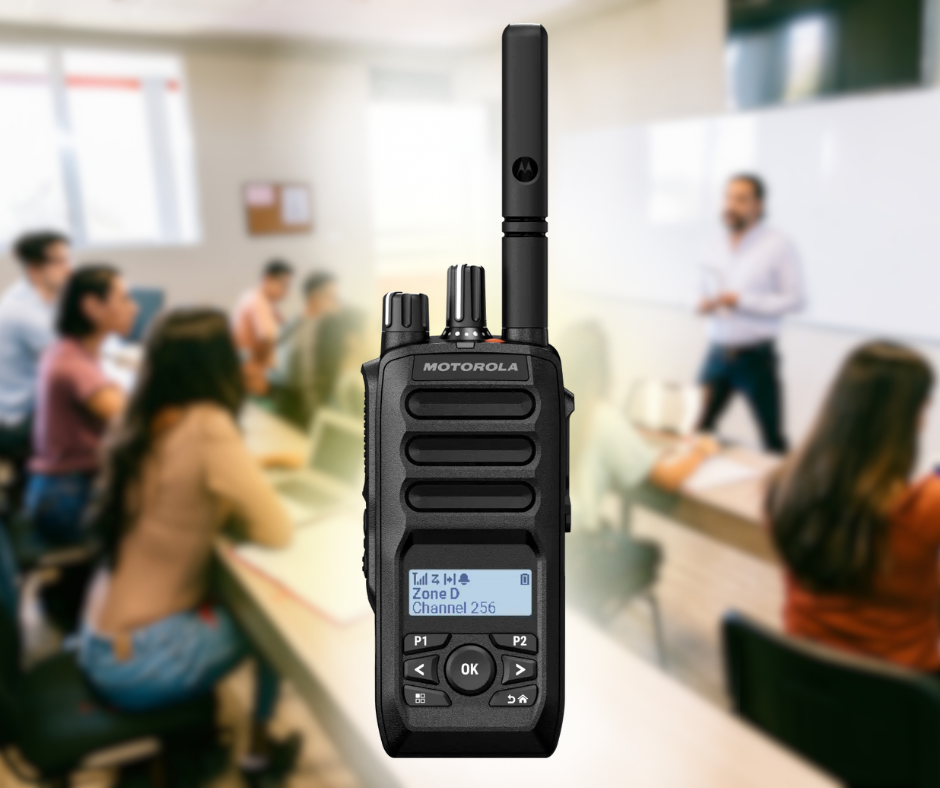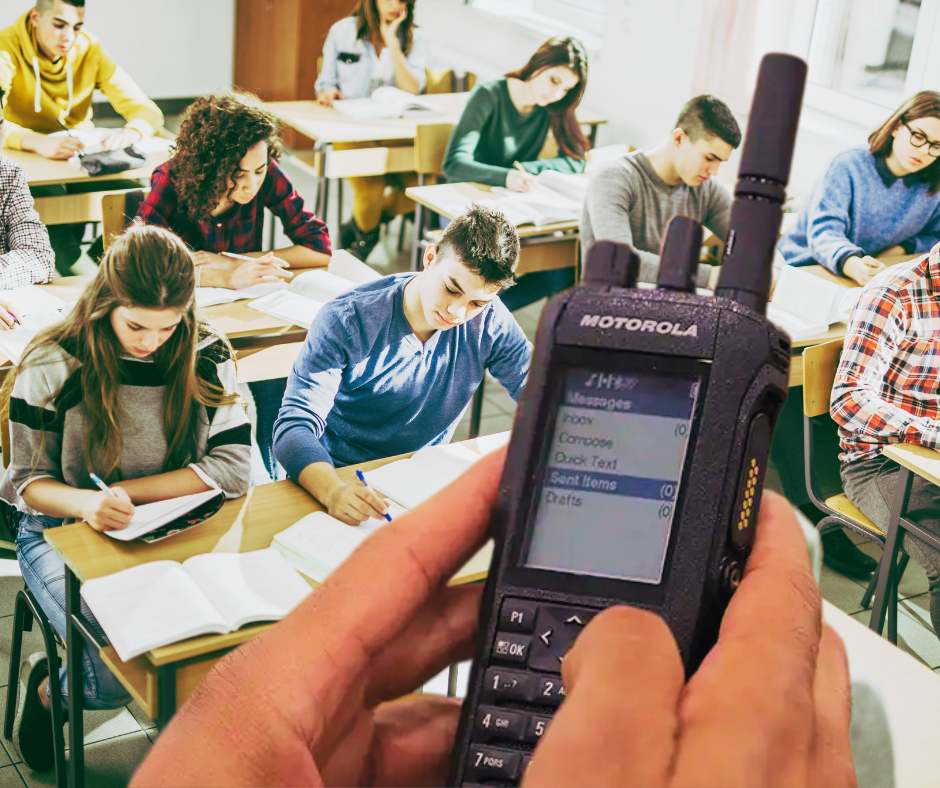Concerns over school safety in the U.S. have intensified in recent years, as headlines continue to report on tragic events that unfold on school grounds. According to Education Week, there have already been seven school shootings in 2025 that resulted in injuries or deaths. Since 2018, the country has seen 228 such incidents, including 39 in 2024, 38 in 2023, and a record-setting 51 in 2022.
These numbers reflect more than just statistics. They represent lives changed forever and a growing pressure on schools to be better prepared. In response, school security guards have become a non-negotiable presence on many campuses across the country. Their roles have evolved beyond monitoring hallways to include emergency response, conflict de-escalation, and real-time communication.
In this article, we’ll explore the wide range of responsibilities school security guards carry, and how tools like two-way radios can help them respond quickly, communicate clearly, and keep school communities safe.
The Growing Need for School Security
While school shootings often dominate the headlines, they’re only one part of a broader safety crisis facing schools today. Violence, bullying, unauthorized visitors, and medical emergencies all pose real and growing risks within the walls of our nation’s schools, and they’ve forced educators and administrators to rethink their approach to student safety.
According to the National Center for Education Statistics, nearly 46% of schools across the U.S. have reported an increase in fights and other physical altercations on campus. On top of that, one in five students (19.2%) say they’ve been bullied at school. This is a number that points to ongoing concerns about emotional and physical safety during the school day.
These challenges go far beyond one-off incidents. They represent a pattern that schools can’t afford to ignore. Parents, teachers, and community leaders are calling for greater accountability, more proactive safety strategies, and a stronger on-campus security presence. The goal isn’t just to react when something goes wrong, but to create a school environment where potential threats are identified and addressed early.
This shift has increased the demand for trained security personnel who are not only visible, but well-equipped to handle a variety of situations. From preventing altercations to assisting during medical events or lockdowns, school security guards are now a central part of campus operations. And with that shift comes the need for clear communication and fast coordination, two critical capabilities that tools like two-way radios can support in real time.
Core Responsibilities of School Security Guards
The presence of school security staff has become increasingly common across the country. In the 2019–20 school year, about two-thirds of public K–12 schools (65%) reported having at least one security staff member present at the school weekly, up from just 43% a decade earlier, according to the National Center for Education Statistics. While newer data is still emerging, it’s likely that those numbers have continued to rise in response to growing concerns about campus safety.
But being visible is just one part of the job. Today’s school security guards wear many hats. They’re expected to act as both protectors and peacekeepers, ready to respond at a moment’s notice to a range of incidents, some routine, others potentially life-altering. Their responsibilities span the entire school day and often go well beyond what many people realize.
Here are some of the core responsibilities that school security guards take on:
- Maintain a Visible Presence: Deter threats simply by being seen in hallways, at entrances, and near outdoor areas.
- Access Control: Monitor who enters and exits the school, check identification, and secure all access points.
- Surveillance and Monitoring: Review security camera footage and remain alert for suspicious behavior or unusual activity.
- Respond to Emergencies: Act quickly in the event of an active shooter, fire, lockdown, or medical crisis.
- Conflict De-escalation: Step in to resolve student altercations calmly and prevent escalation.
- Daily Safety Procedures: Perform routine checks of doors, locks, and the perimeter; assist with drills and emergency planning.
- Relationship Building: Build rapport with students and staff, creating a safer environment through trust and communication.
The Importance of Real-Time Communication
We’ve all heard the phrase, timing is everything. And that is certainly the case, whether it’s a student medical crisis, a fight breaking out in the hallway, or an intruder stepping onto campus. In each of these scenarios, even a 30-second delay in communication can lead to serious consequences.
Let’s explore a hypothetical situation to help land the point. Imagine a student collapses during gym class. The teacher runs to their office phone, but no one answers. They try their cell phone next, but service is spotty in the school’s concrete building. Meanwhile, the clock is ticking. By the time help arrives, valuable minutes have been lost. Minutes that could have made a difference.
This is why schools need communication tools that offer more than convenience; they need speed, clarity, and reliability. Relying solely on cell phones or PA systems is no longer enough. During an emergency, you can’t afford dropped calls, unanswered texts, or messages that don’t reach the right people in time.
Two-way radios are specifically designed to address this challenge. With the push of a button, school security staff can instantly connect with one another, alert administrators, or coordinate with the front office. There’s no dialing, no waiting, and no guesswork. Even better, two-way radios don’t depend on cellular networks, making them far more reliable in large buildings or during high-traffic events when networks may be overloaded.
Whether it’s coordinating a lockdown, calling for medical help, or managing a chaotic situation between classes, real-time communication gives school security guards the advantage they need to respond quickly and appropriately, helping protect students, staff, and visitors in the moments that matter most.

How Two-Way Radios Support School Safety
School security relies on the ability to act without hesitation. When a situation unfolds on campus, communication needs to be immediate, clear, and dependable. That’s why more schools are turning to two-way radios as a key part of their safety strategy.
Unlike cell phones or intercoms, two-way radios are built for quick decision-making and on-the-ground coordination. They give security staff, administrators, and key personnel the tools to respond in real time, without worrying about dropped calls or delays.
Here are several ways two-way radios support school safety every day:
- Instant Connectivity: Security guards can connect directly with other staff members, the front office, administrators, or local law enforcement with a single push of a button.
- Group Communication: Radios allow messages to be broadcast to specific teams or all users at once, making it easy to coordinate during emergencies or large events.
- Strength, Reliability, and Range: Designed for tough environments, two-way radios perform reliably across sprawling campuses, even during storms or power outages.
- Noise-Canceling Features: Advanced models reduce background noise, so communication stays clear even in loud or chaotic situations.
- Privacy and Encryption: Secure channels protect sensitive conversations, keeping student and staff information confidential.
Two-way radios are now part of daily routines. From morning safety checks and perimeter patrols to fire drills and lockdown simulations, radios keep everyone in the loop and ready to act.
At EMCI Wireless, we’ve helped schools across Florida implement reliable communication systems that support both everyday needs and high-stakes scenarios. With our trusted selection of professional-grade two-way radios, school districts can equip their security teams with the tools they need to protect their campuses with confidence.
Supporting a Culture of Safety Through Technology
Creating a safe school environment requires a coordinated effort, supported by the right tools and personnel. While policies and planning are important, it’s the people on the ground who put those plans into action. That’s where the role of the security guard for schools becomes so critical.
Security officer responsibilities have expanded in recent years, shifting from passive observation to active involvement in preventing, responding to, and recovering from incidents. These professionals serve as the eyes and ears of the campus, stepping in quickly when situations arise and working closely with school staff and local responders.
Fast, clear, and reliable communication is what ties these efforts together. When every second counts, a professional-grade two-way radio system ensures that security personnel can stay connected, share real-time information, and respond as a team. It’s about being prepared every single day.
School safety is a shared responsibility. From administrators to teachers to frontline security teams, everyone plays a part. EMCI Wireless is proud to support that mission by providing schools with the reliable communication tools they need to protect students, staff, and visitors. Now is the time to assess your current systems and consider how a better communication strategy can make your campus stronger and safer. Contact us today.

